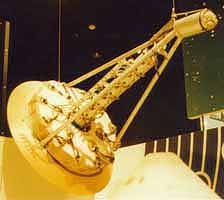(31) Far-out Pathways to Space: Nuclear PowerHeavy elements such as the uranium used in generating nuclear power are extremely concentrated sources of energy. A few pounds of nuclear fuel can produce as much as thousands of tons of coal or oil--or of high explosives, in the case of nuclear bombs. Harnessing nuclear energy for spaceflight therefore seemed a natural direction to explore. But nuclear spaceflight is not easily accomplished. Space rockets require not just energy, but also mass, matter ejected backwards, of which nuclear fuel provides very little. The limiting factor in the operation of rockets is not a shortage of energy but the high temperature at which they operate. Ordinary rocket nozzles already run red-hot: adding extra energy to the fuel would raise the temperature, perhaps beyond what the metal can take. The Choice of Rocket FuelOne possible loophole remains. It is possible to increase the velocity v of the molecules of the hot exhaust without raising the temperature, and therefore also increase the velocity of the exhaust jet, if these molecules are replaced by lighter ones. A hot gas is a collection of independent atoms or molecules, constantly colliding with each other and with the walls of their container. The greater the temperature T, the faster they move. But if one compares different types of molecule at a given temperature, one finds (as noted in the earlier section on the SHARP cannon) that their velocity v differs--it is the kinetic energy (1/2) mv2 which is proportional to T. Suppose one looks at two gases at the same temperature T--one with light molecules of mass m and velocity v, the other with heavier molecules of mass M moving with velocity V. Then by above argument (1/2) mv2 = (1/2) MV2 If (for example) M = 9m, one finds v = 3V. At a given temperature, the lighter molecules move 3 times faster! The most efficient chemical rockets, e.g. those of the space shuttle, burn hydrogen and oxygen to form water (or more accurately, superheated steam). The molecular formula of water is H2O, and since the atom of oxygen (O) is 16 times heavier than that of hydrogen (H), the water molecule has 18 times the weight of the atom of hydrogen, and 9 times the weight of the H2 molecule, the form in which hydrogen usually exists. If only the exhaust jet consisted not of water H2O but of hydrogen H2! Then at the same temperature (as shown above) its molecules would move 3 times faster, and the exhaust jet would be faster too. Unfortunately, there exists no practical chemical reaction which produces H2. With unlimited nuclear power, however, it is not necessary to burn anything--instead, hydrogen gas could be heated inside a nuclear reactor and then ejected backwards from a big nozzle. That was the idea of the NERVA project, NASA's attempt in the 1960s to build a nuclear rocket. It is difficult to imagine running a nuclear reactor at the same high temperature as a rocket engine. But with a factor of 3 in one's favor, even a lower temperature can still give a great advantage. Some experimental models of the nuclear rocket ran quite well when tested on the ground, but in the end, the risk of environmental contamination and of the reactor melting down were too high and the project was stopped. Project OrionA completely different approach to spaceflight was taken by Theodore Taylor, a nuclear physicist. Taylor led a successful career in designing bigger and more powerful nuclear bombs, until personal doubts focused his talents elsewhere. Taylor visualized nothing less than a spaceship propelled by atomic bombs. Its rear would hold a massive metal plate, with an opening in the middle. At suitable intervals an atomic bomb would be ejected from there and after it reached some specific distance, it would be exploded. The bomb would be wrapped in a hydrogen-rich plastic casing, which the enormous heat of the bomb would instantly turn into extremely hot gas, much of it hydrogen. That gas would then be blown off into space, but some would first hit the plate, and its pressure would propel the spaceship upwards. The idea was first raised by Ulam and Everett in 1955, before any practical spaceflight was achieved (Stanislaw Ulam was also the mind behind the first practical design for an H-bomb; see "Dark Sun" by Richard Rhodes). In 1958 Taylor obtained Air Force support and the project, named "Orion", was begun. It attracted a crew of practical dreamers, among them Freeman Dyson, a distinguished theoretical physicist from the Institute of Advanced Studies in Princeton.
Over the seven years that followed, at the cost of about 10 million dollars, plans for a bomb-propelled spaceship were developed. Small models of such a ship were actually built, and in one successful experiment a model was propelled upwards by a series of conventional explosive charges, ejected from its rear. Although the detailed design remains classified (it involved a great deal of bomb technology), the designers have claimed that no technical problem posed a stumbling block--neither the wearing-down of the "pusher plate" exposed to the explosions, nor the radiation hazard to the spaceship passengers, nor any other details. "Orion" called for huge spaceships, weighing thousands of tons. One design proposed a flight to distant stars using a "conservatively designed" spaceship of 40 million tons, powered by 10 million bombs! But in the end, the project was abandoned, because the prospect of exploding a large number of nuclear bombs in the atmosphere or close to it seemed too frightening. The world woke up to realize the extent to which radioactive debris contaminated the atmosphere, and signed in 1963 a treaty banning nuclear tests, which also spelled the end of "Orion". |



